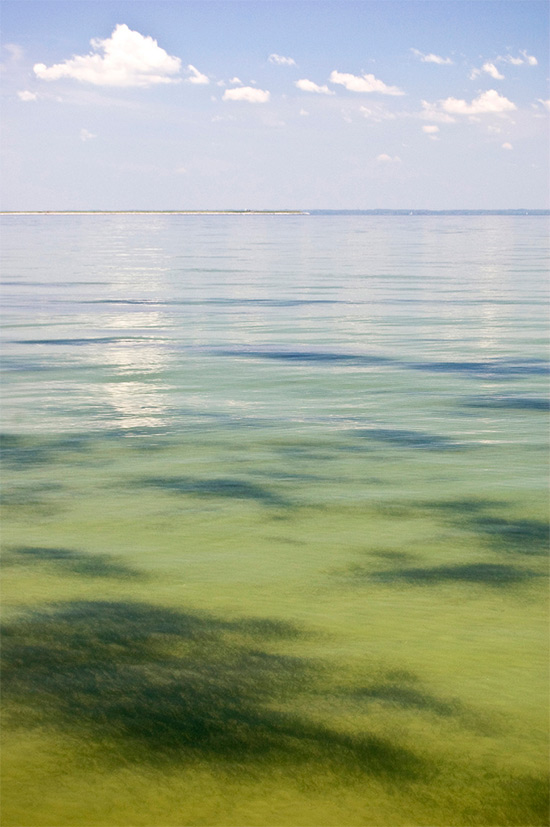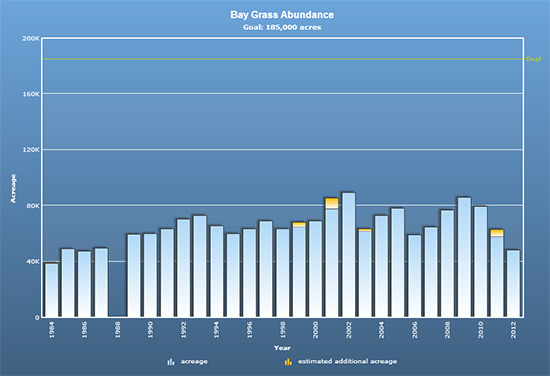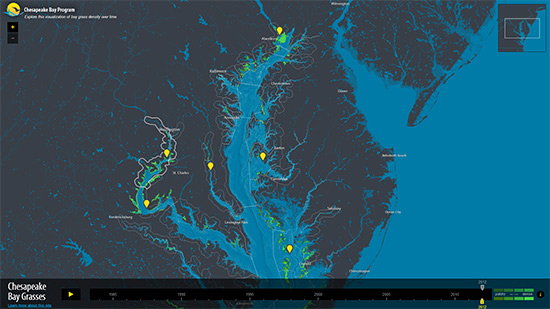Chesapeake Bay’s underwater grasses decline in 2012
A 21 percent loss in underwater grasses in the Bay and its tidal rivers reflects lows last reported in 1986.
Close to 15,000 acres of underwater grasses have disappeared from the Chesapeake Bay.
While robust grass beds on the Susquehanna Flats and expanding beds in the James River offer two examples of the Bay’s resilience, an aerial survey conducted by the Virginia Institute of Marine Science (VIMS) showed a 21 percent decline in the Bay’s grasses in 2012. This so-called “alarming” loss—from just over 63,000 acres in 2011 to just over 48,000 in 2012—approaches lows last reported in 1986.

In a report released this week, Chesapeake Bay Program scientists attributed last year's decline in grass beds to warmer-than-normal water temperatures seen in 2010 and strong storms seen in the fall of 2011. The former "cooked" grasses in the Lower Bay, while the latter pushed excess sediment into rivers and streams, clouding the water and creating unfavorable growing conditions for aquatic plants in the Upper and Middle Bay.

These strong storms and episodes of heat stress have occurred alongside a widespread decline in water clarity, said Bob Orth, coordinator of the VIMS Submerged Aquatic Vegetation Survey. While Orth remains "concerned" over the decline in bay grasses, he noted that favorable growing conditions in the future could lead to quick signs of recovery in a species that is fast to respond to water quality changes—both good and bad.
"The best thing we can do [for bay grasses] is to improve water quality," said Lee Karrh, a biologist with the Maryland Department of Natural Resources (DNR) and chair of the Bay Program's Submerged Aquatic Vegetation Workgroup. "If you improve water quality and reduce chronic problems, then the Bay should be able to deal with episodic events easier than it has been able to in the past."
Underwater grasses—also known as submerged aquatic vegetation or SAV—are critical to the Bay ecosystem, offering food and habitat to countless critters while absorbing nutrients, trapping sediment and reducing shoreline erosion. The Bay Program uses underwater grass abundance as an indicator of Bay health, and has this week released a data visualization tool that allows users to track changes in grass abundance over time, as dominant species ebb and flow and grass beds shrink and expand.
Read more about the 2012 Distribution of Submerged Aquatic Vegetation in the Chesapeake Bay.


Comments
As a person who has lived on the Bay for over 30 years in Deale, Md., I would like to put my two cents in about what a pitiful drop in the bucket this cleaning and restoration of the Bay has been. I personally do not swim in the Bay anymore and I can tell you firsthand it is not getting better. In order to clean the Bay some RADICAL changes need to be made, not these little action plans. You will never restore the Bay to its former self. Nothing on the planet will ever be what it once was.
First, stop all weed chemicals from being used in and around the Bay. These million dollar homes on the water with the beautiful lawns, you don't think that chemical runoff is killing the grasses? Next, introduce an invasive species of oyster we can eat and the watermen can harvest. The Bay can get filtered again and the jobs can come back. The native oysters cannot live in these waters anymore. Stop wasting money on them. So the phragmites is invasive, its roots also filter runoff from the polluted streets. The native plants are not growing and we need some sort of barriers. I have eight acres on Rockhold Creek in Deale and used to have a sod farm rent our land to grow sod on. We kicked them off because of all the chemicals going into the Bay. Now they are just up the road. How can this be allowed? I for one am not for "restoring" the Bay but "changing it" to live in the 21st century.
Thank you!
Your comment has been received. Before it can be published, the comment will be reviewed by our team to ensure it adheres with our rules of engagement.
Back to recent stories